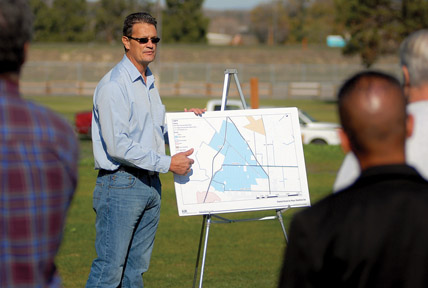
Water district aims to show local growers that irrigation with
treated wastewater is a safe way to grow crops
Hoping to help meet some of the future irrigation needs of
growers, San Benito County Water District officials last week
showed off a lettuce and spinach demonstration garden grown with
water reclaimed from Hollister’s wastewater treatment plant.
Water district aims to show local growers that irrigation with treated wastewater is a safe way to grow crops
Hoping to help meet some of the future irrigation needs of growers, San Benito County Water District officials last week showed off a lettuce and spinach demonstration garden grown with water reclaimed from Hollister’s wastewater treatment plant.
With agricultural water deliveries from the Central Valley Project lower than historical levels and not projected to increase, “recycled” water like that used on the test garden could add up to 4,000 acre-feet of water to the region’s water supply. An acre-foot equals 325,851 gallons of water.
The meeting, which featured local growers, elected officials and water district personnel, was held at the city’s river park site, a 50-acre grassy park on the west end of the San Juan Hwy. bridge.
“This really can work and is something that we’d like to move forward with,” said Jeff Cattaneo, head of the county water district. “We’ve heard from growers. They had some concern [about irrigating with water recycled from the treatment plan] and they wanted assurance it was a viable water supply.”
To assuage some of those concerns, the water district planted a 25-foot by 250-foot garden of Missoula lettuce and baby spinach on Oct. 9 and has been doing weekly water-quality monitoring for general minerals and pathogens such as E. coli, shigella and salmonella. They have also analyzed the soil and plan to sample the plant tissue at the end of its growing cycle.
As of the Nov. 19 meeting, all water tests for pathogens had come up negative, indicating the water was safe to use, officials said.
“We wanted to help assure you that the water would be pathogen-free,” Cattaneo told the assembled growers. “All tests have come back negative and there have been no issues at all.”
The district is seeking input from growers about what information they need in order “to feel comfortable with the product,” Cattaneo said, noting that no soil amendments, fertilizers or pesticides were used in the demonstration garden, which is on the northern edge of the Brigantino/Riverside Park Project. Testing on the soil will continue as long as the city is irrigating the plot and Natural Selection Foods will test the greens at some point.
When one person at the meeting said, “The most important thing for a grower is the market for the product,” Cattaneo noted that the testing will help confirm the safety of the process and the cost of the recycled water will be set at a point that it makes sense for growers to use.
“It doesn’t make sense to price it where you can’t make money” irrigating your crops with it, he said.
Water from Hollister’s new treatment plant on San Juan-Hollister Road near the junction of Hwy. 156 is not approved for drinking but it is suitable for irrigation of vegetables as well as lawns, yard and park landscaping and other similar uses.
The local Reclaimed Water Irrigation Project, officials say, is a good substitute for groundwater or imported surface water that is typically used for irrigation.
Otto Kramm, chief operating officer of Mission Organics, said that although the recycled water irrigation project “is in the infancy stages, results look promising.”
Gina Colfer of Mission Organics said that “acceptability by the packer/shipper is the key,” meaning that if crops grown with recycled water can be sold with the same quality assurances as crops grown with traditional water sources, growers may be more likely to use that water.
Delivery of the recycled water locally, Colfer noted, is another issue.
“They’d have to get the infrastructure in place. Is that going to be an additional cost?” she asked.
Cattaneo said an expanded test plot – up to five acres – is expected to be planted along Wright Road near a pipeline that could deliver recycled water.
“We’re looking at working with a grower in that area to demonstrate long-term the benefits of using this water,” he told the gathering. “I’m assuming you guys would like to see more than three months’ data.”
Dave Kranz, manager of media services for the California Farm Bureau, said agriculture is the largest user of recycled water.
“We are generally supportive of reclaimed water, especially as a supplemental supply or when other water supplies are short,” he said. “We don’t, however, want the state to require that reclaimed water be used where the fresh water supply is ample. We are interested in making sure that any time that recycled water is used, it is only when it is cost-effective, safe and it won’t harm the ground or the crops.”
The next phase of the local recycled water project will help lower the salt content and total dissolved solids in local water, with a goal of making it “compatible with the irrigation of high-value crops by 2015,” according to a statement from the water district, which will work with the City of Hollister on the project.
The Brigantino/Riverside Park Project’s turf area is irrigated with treated water from the sewer plant. The park, which is owned by the city, is expected to open for public use in the spring.









